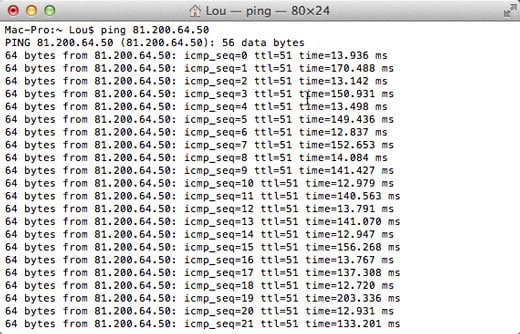This short tutorial will show you how to Ping on Apple Mac OS X. This is done using the Mac OS X version of the CMD Prompt. Browse other questions tagged networking mac-osx ip ping terminal or ask your own question. The Overflow Blog Getting started with contributing to open source. Podcast 257: a few of our favorite haxx. Featured on Meta Improved experience for users with review suspensions. Using networksetup. The networksetup tool offers an enormous amount of information on your. Ping is available in Windows, Linux, and MacOS as a diagnostics tool for network connections. In our article on ping command basics, we already introduced you to the command line program’s functions. To complement this, we’ll show you below how you can use ping for continuous tests.
Ping is available in Windows, Linux, and MacOS as a diagnostics tool for network connections. In our article on ping command basics, we already introduced you to the command line program’s functions. To complement this, we’ll show you below how you can use ping for continuous tests.
Continuous ping in Windows 7, 8, and 10
In Windows, the ping sends four data packets in its default setting to the target computer you specified by IP address or host name. If you would like to test the network connection between two computers on an ongoing basis, the “continuous ping” option is available.
Follow these instructions to run ping in Windows 7, 8, or 10 as a continuous test.
Step 1: Open the Windows command prompt. One way of doing this is by entering the key combination Windows + R and enter the command CMD.
Step 2: Enter the command line ping with the -t option and any address and confirm by clicking [Enter].
Windows runs the command line program as a continuous ping in an endless loop.
For each incoming response packet, ping issues an entry on the standard output (stdout). Provided that you haven’t added any other settings, the information will be recorded directly into the terminal. The output comprises the IP address of the pinged computer, the size (in bytes) of the response packet, the response time in milliseconds (ms) as well as the TTL (Time to live).
The echo queries are dispatched every second to the target computer until you end the command line program with [Ctrl] + [C].
If you stop the ping, the program displays a statistical summary (ping statistics) at its conclusion.
If needed, you can redirect the standard output to a text file. To do so, you add the appropriate operator (the greater-than symbol) as well as the file name (including the extension).

If no file is found under the specified file name, it will be automatically generated. In the example presented above, we redirect the standard output to a txt file named logfile.
Both the information on the incoming data packets and the ping statistics will be recorded in the text file you have specified.
You’ll find an overview of the most important CMD commands in our article on the basics of the Windows command prompt.
Continuous ping in Linux
In Linux, the ping command line program is already run on an endless loop in the default setting. Follow the instructions below to perform a continuous ping test in a Linux system.
Step 1: Open the terminal for your Linux distribution in Ubuntu. One way to do this is with the key combination [Ctrl] + [Alt] + [T] (Genome, KDE).
Step 2: Enter the ping command and the target computer’s address in the command line and confirm by hitting [Enter].

In Linux, the redirection of the standard output to a text file occurs according to the same syntax as that used in Windows.
If you’d like to have the continuous ping issue a timestamp, use ping with the -D option. In this case, the output for each incoming response packet is preceded by a UNIX timestamp.
If you don’t want to run ping on an endless loop in Linux, define the ping quantity with the -c option according to the following example.
The target computer with the IP address 93.184.216.34 is pinged exactly four times before the program terminates itself.
We provide an overview of the most important Linux commands in our article on the Linux terminal.
Continuous ping in MacOS
In MacOS, the ping command line program is also run as a continuous ping in the default setting.
Follow the instructions below to run ping in MacOS as a continuous test:
Step 1: Open the terminal. You’ll find the Mac terminal under “Applications” in the subfolder “Utilities”.
Step 2: Run the ping commandwith the address of the target computer.
In MacOS, you redirect the standard output according to the same procedure you would use in Linux and Windows.
Run a ping test as you would in Linux with a user-defined quantity of echo request queries by choosing option -c.
You’ll find further information on ping command in Windows, Linux and MacOS in your operating system’s manual. Enter the command manping in the terminal in order to open the manual page for the corresponding command line.

MTU stands for “Maximum Transmission Unit.” Whenever you transmit and receive data in Mac OS X, the data is broken up into smaller pieces (called packets) and then reassembled on the other end of the connection. Think of it like a jigsaw puzzle: You go to the store to find a puzzle, and they come in different sizes, ranging from 20-10,000 pieces. Everyone knows that the more pieces you need to put the picture back together, the longer it takes. The same thing is true with computer data.
Suppose, you want to download a song from the iTunes Music Store. Or you’ve come across a freshly released movie that you planned to watch this Friday night. Or you want to save on your computer an audio or video guide containing advice to help with personal statement writing. Naturally, you want to get all of these things as quickly as possible. And as you increase the amount of data in a packet, you decrease the number of packets iTunes needs to transmit, which reduces the time it takes to receive the file. That’s great until you tell the computer to transmit packets larger than your ISP can handle. If your ISP can handle 1500 bytes, but you specify 1800 bytes, you might get the 1500 bytes, but then your computer has to tell iTunes, “Hey, I didn’t get those other 300 bytes. Please resend them.” iTunes sends the data, but it has to do so in a new packet, which means it takes longer to get all the data to your computer.
Determining the MTU for your current network is not difficult, but it is a matter of trial and error. There are some caveats. First, each network has its own MTU, so your home network may be different from work and from the local coffee shop. Thus, if you set a custom MTU and then change networks, you probably need to change the MTU to match the new network. Second, the standard MTU size for Ethernet/AirPort connections is 1500. For Ethernet DSL (PPPoE), it is 1492. Third, it is unlikely your MTU size is greater than 1500 or lower than 1400, but feel free to experiment with different values.
When you want to be able to manually set your MTU size, you must first open System Preferences, then the Network system preference. When that preference opens, select the network interface you use to connect to the Internet (likely Ethernet or Wi-Fi), and then press the “Advanced” button in the lower right corner of the window. When the Advanced window appears, you can then click on the “Hardware” tab (or the “Ethernet” tab if you’re running Snow Leopard or earlier). This is the section where you can edit the MTU value. Mac OS X can already determine your network’s proper MTU, so only adjust this setting if you are experiencing persistent slowdowns, especially when attempting to download files. Read on to determine your ideal MTU value.
Mac OS X can already determine your network’s proper MTU, so only adjust this setting if you are experiencing persistent slowdowns, especially when attempting to download files.
To determine your network’s MTU:
Ping Test On Mac
- Open Terminal (in your Utilities folder). You are going to “ping” another server. This means you are going to send another server a little bit of data and ask it to respond to you. It is the equivalent of tapping someone on the shoulder, except in this metaphor, you get no response when you tap someone too hard (or send a packet that is too large).
- Type this command and press Return:
ping -c 2 -D -s 1472 example.com
- The -c switch tells ping how many packets to send. I chose to specify two packets. You could choose 1 or 100 or even eliminate this switch to ping endlessly (not recommended, but if you do this and need to stop the ping, hold down the Control key and press the letter “C”).
- The -D switch tells ping not to fragment the packet (meaning that if the size of the packet is too large, don’t send it at all).
- The -s switch allows you to specify the size of the packet in bytes. That is what the 1472 next to the -s switch. This is important: Any ping that you do via the above method adds 28 bytes of overhead to the ping. This means you must add 28 bytes to the size of your packet to get the packet’s true size. In the above example, we pinged example.com with 1472 bytes. Add 28 to that number, and you get 1500. If 1472 is the largest packet you can successfully send, then your MTU value is 1500. If the largest packet you could send were 1464, then your packet size would be 1492.

- When you run the above command, ping can give you two different replies:
ping: sendto: Message too long
If you get a response that the message is too long, that means the packet size is too large and must be reduced.
1480 bytes from 208.77.188.166: icmp_seq=0 ttl=46 time=185.42 ms
- The above line is the other reply you may receive from ping, and it indicates a successful ping. Your response may look slightly different: the IP address may change, the time it takes to ping may change, etc. The point is that this line looks very different from the “message too long” line. If you ran the exact command from above, you should see either two successful pings or two failed pings, since the -c switch was set to
- In fact, at the end of the ping process, you may see a statistics line that shows either 0% packet loss or 100% packet loss (0% means every packet went through, 100% means none of the packets did).
- Your goal is to continually increase the packet size in the ping request until you receive a “message too long” reply (or, if you are only receiving those messages, lower it until you can successfully ping a server). Add 28 to the largest packet size you can successfully ping, and this is your MTU. To manually set your MTU in the “Hardware” tab of the Advanced window in the Network system preference, change the “Configure” pop-up menu form “Automatically” to “Manually.” Then, switch the “MTU” pop-up menu from “Standard” to “Custom.” Finally, enter your MTU in the box that appears and click OK to save your settings.
Stop Ping Mac Terminal
Did this guide work for you? How important do you feel it is to edit the MTU value? How has it affected your network performance? Let others know in the comments.

